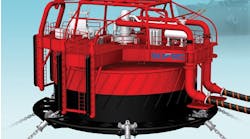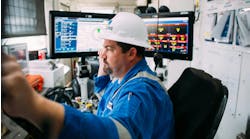Michael Konopczynski
WellDynamics International Ltd.
Promises of reduced capex and opex, increased production rates, and improved hydrocarbon recovery make intelligent well technology and intelligent field development an attractive option. To date, over 130 intelligent well completions globally have demonstrated the value of this technology. Operators in the North Sea, deepwater Gulf of Mexico, Atlantic Canada, West Africa, and the Asia Pacific region are beginning to approach asset development planning with a focus on exploiting the value that intelligent wells can provide to their projects.
To best exploit the advantages of intelligent wells, operators need to consider six critical issues that impact investment in intelligent wells.
Getting the big picture
Intelligent well technology has become a proven technology. With the success of individual intelligent wells, there is obvious value in exploiting intelligent well technology when planning full field development. Of course, not every well in a field development plan needs to be intelligent – some developments can achieve maximum benefit from selective application of the technology to critical wells.
Even greater rewards can be achieved by expanding the horizon of application beyond the trial wells and isolated field development. Screening a portfolio for potential application of intelligent well technology can unlock marginal development opportunities with low economic value or low probability of success. A stochastic approach to analyzing the value of the portfolio and managing risk through multiple applications of intelligent well technology can maximize asset value.
Exploiting reservoir uncertainties
Including intelligent well technology in reservoirs characterized by variability is like buying an insurance policy against uncertainty. The operator makes an investment early in the development to provide the flexibility to deal with unanticipated behavior and performance of the reservoir and wells.
The key to determining how useful the technology can be is asking a few critical questions:
- What is the drive mechanism?
- Is the aquifer active?
- Is the reservoir compartmentalized?
- Are there large heterogeneities in areal permeability?
All of these questions, which are difficult to address early in the life of an asset due to limited appraisal drilling and a dearth of production and reservoir data, can have a profound impact on a field development plan. Experience teaches that uncertainties can lead to additional "unforeseen" capital expenditure. Remediating existing wells and adding new wells when the reservoir does not behave as anticipated in the original field development plan can be costly.
To properly assess the value of investing in intelligent well technology to address uncertainty in reservoir behavior requires a stochastic evaluation process. An operator who takes advantage of the opportunity to exploit reservoir uncertainty can improve the economics of a project early in the planning process.
Most petroleum engineers are not well versed in the capabilities and applications of intelligent well technology. As a result, the use of intelligent well completions often comes under consideration well after field development concepts are entrenched in the asset development plans. When this happens, the full value and potential impact of exploiting intelligent well technology is not realized.
In fact, the best results are achieved when the benefits and capabilities of intelligent well technology are considered in the conceptualization stage of field development planning. When decisions are made early on, the operator can lessen the number of wells required to develop a field, reduce infrastructure, trim facilities and operating cost, accelerate production, and maximize recovered reserves.
Considering intelligent well technology early in the asset development plan also ensures that critical interfaces necessary to implement the technology are in place to expedite installation and minimize costs.
Despite the increasing maturation of intelligent well technology, there is still a significant element of application customization and long lead times on some of the downhole components. New technology and improved designs are constantly evolving, particularly focusing on improved reliability and lower costs. As such, intelligent well equipment suppliers are reluctant to build a large inventory of equipment. Until the market grows significantly, intelligent well completion equipment generally will not be offered as an "off-the-shelf" product.
Establishing functionality
An operator who invests in intelligent well technology without clearly understanding the functionality required faces two dangers – paying too much for functionality that is not needed, or missing functionality that is needed to maximize the value of the asset.
There is a wide range of products on the market with varying intelligent well functionality. These products can be divided into flow control options and sensing options.
In evaluating downhole control valves, there are several flow control capabilities, actuation methods, and choke trim designs from which to choose. The type of fluid being controlled, whether oil, gas, water, or a mixture of the three, and the choking capability required dictate the options.
Each option affects the controllability of the flow, the supporting hardware and control systems, and the number of control lines/ cables required. Selecting the right flow control option is critical because the choice can change the number of zones/intervals that can be realistically controlled in one well and can influence the overall reliability of the integrated system.
There are many permanent sensor technology options. The most widespread downhole sensor technology in use is electronic pressure/temperature gauges. By combining pressure/temperature gauges with a differential pressure flow measurement element, such as a venturi, a number of suppliers have been able to offer downhole flow meters. Optical fiber distributed temperature sensors are now a mature technology, and emerging technologies such as optical fiber pressure sensors, optical fiber passive acoustic flow meters, and distributed electronic resistivity arrays are now undergoing trials and field applications.
With all these options, the petroleum engineer can easily fall into the trap of selecting more functionality than is economically required. Dynamic reservoir modeling employing integrated intelligent well functionality and modeling can assist in assessing the incremental economic benefit from each option. When combined with reliability modeling and "real option" analysis, a risked estimation of the economic benefit of each intelligent well option can be evaluated. Ultimately, the objective is to get the right level of smartness in the right wells in the right reservoirs at the right price.
Focusing on interfaces
Once the functionality of the intelligent well completion has been identified and economically evaluated and the corresponding intelligent well equipment has been screened for practical application (sizes, pressure, and temperature limitations, for example), the process of detailed completion design and system integration can begin.
This is no small task and requires close cooperation among the operator, the intelligent well equipment supplier, the wellhead supplier, and in some cases, the artificial lift, multi-lateral, and sand control suppliers.
Direct hydraulic, binary control, easily accessible land-based intelligent well installations generally present the simplest integration requirements. Conversely, deepwater, remote subsea wellhead applications present some of the most challenging interface issues. The reason is that intelligent well controls must be integrated with subsea wellhead, safety valve, and umbilical controls. By examining and addressing installation and interface issues early on, experienced project personnel can speed implementation, reduce costs, and avoid unforeseen problems.
Key interface and integration considerations include:
- Ratings – pressure, temperature, loading forces, environmental (corrosion and materials)
- Mechanics – well architecture and completion equipment, particularly wellhead (control line penetrations), subsea control cani- sters, surface control equipment housings, footprints, and environmental requirements
- Hydraulics – fluid compatibility, pressure ratings, cleanliness requirements, volume requirements, duty cycles
- Electrical components – power supplies, voltage and current requirements, conductors, electro-magnetic compatibility, and immunity, duty cycles
- Communications – communication standards and protocols, available bandwidth, data transmission requirements, links to supervisory control and data acquisition (Scada), distributed control systems (DCSs), and corporate IT networks
- Control systems – stand-alone or integrated with DCSs, safety and shut-down systems.
Extensive system integration testing must be conducted to ensure the elements work properly with one another in the appropriate environmental conditions before equipment is deployed. Intelligent well completions and integration with other systems can be complex, and the operator must provide the time and expedite the supplier interfaces to ensure trouble-free implementation and operation. Failure to do so at the appropriate level can erode the value that intelligent wells can bring to the project.
Information and functionality
Once an intelligent installation is in place, a critical question arises: What do you do with it? This is a serious question because it can mean the difference between realizing the full value of an intelligent completion investment and getting value from only a few of the system's capabilities.
The significant benefit of intelligent well technology is realized when production information generated by downhole and field-deployed sensors is used to make decisions to actively modify each zone in the well and thereby optimize production and manage reservoirs in near real time. This is the essence of the intelligent field management process.
To effectively exploit this technology requires work processes, data management, and optimization routines that permit frequent adjustment and fine tuning of the intelligent wells.
Essential components of an intelligent well reservoir management system are:
- Downhole sensors and flow control devices
- Data acquisition and process control system
- Data scrubbing, validation, storage, and retrieval
- A range of petroleum engineering, econ-omic, management, and visualization appli- cations
- A communication and work environment providing "real-time" data access, processing, collaboration, and reporting
- A well-defined and agreed upon reservoir management philosophy that exploits the operating flexibility of the intelligent wells.
The challenge to the intelligent field operator is to integrate all of the intelligent well reservoir management system's components to work toward a common goal of proactive reservoir management for intelligent wells. The process begins with data collected from multiple sensors within a wellbore and progresses through the value chain to an integrated asset management organization. This organization is characterized by team members from a broad spectrum of corporate functions making timely decisions derived from all of the available data to control injection and production.
Short-term reservoir management focuses on production performance at the completion or zone level, with objectives of maximizing hydrocarbon production and short-term profitability. Long-term reservoir management focuses on maximizing hydrocarbon reserves recovered and net present value for the asset.
Balancing the decisions of short-term objectives versus long-term objectives is the key to effective reservoir management. Intelligent wells provide the petroleum engineering expert and asset manager with tools and capabilities to improve performance in both the short term and long term.
Critical to this objective are the data collection and data management processes and systems to deliver the information to the petroleum professional. Intelligent field processes are well suited to web-based information processes, taking advantage of globally deployed expertise in virtual teams. Most important, the production operations personnel must be fully integrated in the decision process and take ownership of the adjustment and control of the intelligent wells.
Putting technology to the test
Oil and gas companies are working to increase recovery of their hydrocarbon reserves from existing assets and are exploiting assets that are more difficult to develop than ever before. Intelligent well technology is a key enabler to assist these pursuits. But to effectively realize the benefits from intelligent well technology, the operator must focus on the potential applications, reservoir uncertainties, timing of development planning, functional requirements, detail design, and management philosophies and systems. By putting all of these elements in place and developing an organizational understanding of the capabilities of intelligent wells, the operator can ensure maximum value from an intelligent well investment.
Author
Michael Konopczynski is the manager of reservoir technology at WellDynamics International in Aberdeen, Scotland. WellDynamics is a provider of intelligent well equipment and services, with over 87 SmartWell installations worldwide. A complete list of references is available from the author by email at [email protected].





